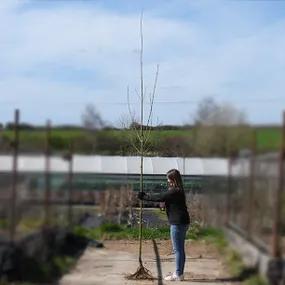Harlequin Norway Maple, Large Trees
Honest Delivery Prices- European. Likes chalk.
- Variegated leaves. Great autumn colour.
- Max. Height: 12m
- Requires Yearly Pruning
- Bareroot Delivery: Nov-Mar
Recommended extras
Description
Acer platanoides Drummondii: Bareroot Harlequin Norway Maple Trees in Standard Sizes
Acer platanoides Drummondii, the Harlequin or Drummond Maple, is a variety of Norway maple with variegated leaves. They have the classic maple star shape with a bright green centre and creamy margin. Acer drummondii produces small clusters of pale yellow flowers called corymbs in April, before the branches get covered in foliage. The leaves look great when the full sun shines through them. In autumn, they turn a clean, shining yellow, sometimes with orange tones. The mature bark is steely grey with vertical fissures that reveal rusty flashes of deeper wood.
We grow another ornamental Norway Maple variety, Acer Crimson Sentry.
They can reach a height of about 12 metres, which is about half the size of a wild Norway Maple, suitable for a medium-sized garden.
Browse our other Maple varieties, or all of our trees.
Delivery season: Maple trees are delivered bareroot during late autumn and winter, approximately November-March inclusive.
Choosing a size: Small trees are cheaper, easier to handle and more forgiving of less than ideal aftercare, so they are best for a big planting project. If instant impact is your priority, or if you are only buying a few plants for use in a place where it is convenient to water them well in their first year, then you may as well use bigger ones. All our bareroot trees are measured by their height in centimetres above the ground (the roots aren't measured).
Features:
- Height: 12m
- Soil: Any with decent drainage, except very poor and dry
- Green leaves with creamy margin
- Yellow Autumn colour
- Bareroot delivery only: November-March
Growing Harlequin Maples
This hardy and unfussy tree will grow in almost any soil apart from peat or shallow chalk, and it won't thrive on very poor, dry soil. It loves clay and although it won't grow in wet soil, it doesn't mind a bit of winter waterlogging or flooding. It is quite shade-tolerant and totally pollution resistant.
It is suitable for very exposed locations, but not on the coast.
Other plants generally don't grow under it due to the shade it casts and the dense root system.
Like quite a few variegated trees, it is sometimes prone to reversion back to green. You must cut out such growth as soon as possible, or it will spread until the whole tree loses its variegation.
Planting Instructions
Notes on planting Acer drummondii Maple trees:
Your trees will grow in pretty much any soil, only very acidic, sandy or very wet soils should be avoided. They are fully hardy and won't suffer in frosty areas.
Partial shade is fine, although more shade can affect the quality of the variegation.
Prepare your site before planting:
It is good to dig over the site where you plant a tree several months in advance. Kill the weeds first: for tough weeds like nettles, brambles and ground elder, you will usually need a weed-killer to get rid of them. When you dig the soil over, remove stones and other rubbish and mix in well rotted compost or manure down to the depth of about 2 spades.
Watch our video on how to plant a tree for full instructions.
Remember to water establishing trees during dry weather for at least a year after planting.
Tree Planting accessories:
Prepare your site for planting by killing the weeds and grass.
You can buy a tree planting pack with a wooden stake & rubber tie to support the tree and a mulch mat with pegs to protect the soil around the base of your tree from weeds and drying out.
We suggest that you use mycorrhizal "friendly fungi" on the roots of all newly planted large trees: if your soil quality is poor, we strongly recommend it.
You can also improve your soil with bonemeal organic fertiliser.
Did You Know?
This tree was bred at the Drummond Nursery in Stirling, Scotland, around 1903, and is one of the most popular cultivars of the species.
Standard trees are measured by their girth in centimetres 1 metre above ground level: their trunk's waist measurement. Unlike sapling trees and hedge plants, standards aren't measured by their height, which will vary quite a bit both between and within species.
So, a 6/8cm standard tree has a trunk with a circumference of 6-8cm and an 8/10 standard has a trunk 8-10cm around. This measurement makes no difference to the tree's final height.
On average, standard trees are 2-3.5 metres tall when they arrive, but we cannot tell you precisely how tall your trees will be before we deliver them.

 Hero Img.webp)
 Hero Img.webp)

